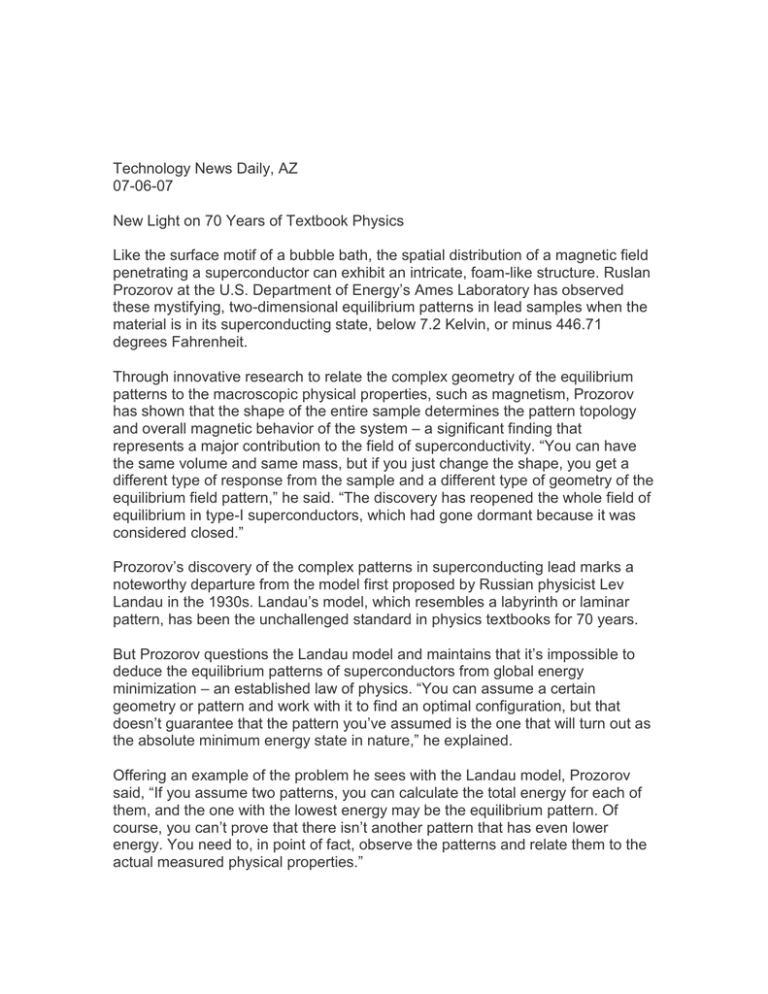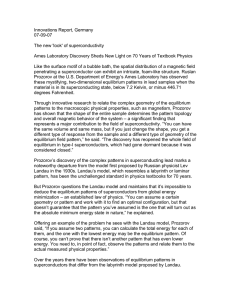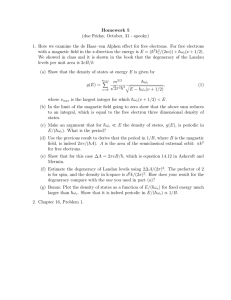Technology News Daily, AZ 07-06-07
advertisement

Technology News Daily, AZ 07-06-07 New Light on 70 Years of Textbook Physics Like the surface motif of a bubble bath, the spatial distribution of a magnetic field penetrating a superconductor can exhibit an intricate, foam-like structure. Ruslan Prozorov at the U.S. Department of Energy’s Ames Laboratory has observed these mystifying, two-dimensional equilibrium patterns in lead samples when the material is in its superconducting state, below 7.2 Kelvin, or minus 446.71 degrees Fahrenheit. Through innovative research to relate the complex geometry of the equilibrium patterns to the macroscopic physical properties, such as magnetism, Prozorov has shown that the shape of the entire sample determines the pattern topology and overall magnetic behavior of the system – a significant finding that represents a major contribution to the field of superconductivity. “You can have the same volume and same mass, but if you just change the shape, you get a different type of response from the sample and a different type of geometry of the equilibrium field pattern,” he said. “The discovery has reopened the whole field of equilibrium in type-I superconductors, which had gone dormant because it was considered closed.” Prozorov’s discovery of the complex patterns in superconducting lead marks a noteworthy departure from the model first proposed by Russian physicist Lev Landau in the 1930s. Landau’s model, which resembles a labyrinth or laminar pattern, has been the unchallenged standard in physics textbooks for 70 years. But Prozorov questions the Landau model and maintains that it’s impossible to deduce the equilibrium patterns of superconductors from global energy minimization – an established law of physics. “You can assume a certain geometry or pattern and work with it to find an optimal configuration, but that doesn’t guarantee that the pattern you’ve assumed is the one that will turn out as the absolute minimum energy state in nature,” he explained. Offering an example of the problem he sees with the Landau model, Prozorov said, “If you assume two patterns, you can calculate the total energy for each of them, and the one with the lowest energy may be the equilibrium pattern. Of course, you can’t prove that there isn’t another pattern that has even lower energy. You need to, in point of fact, observe the patterns and relate them to the actual measured physical properties.” Over the years there have been observations of equilibrium patterns in superconductors that differ from the labyrinth model proposed by Landau. However, the unusual patterns were considered to be defects or fluctuations due to imperfections in the material under study. No one bothered to relate the patterns they were observing to macroscopic properties. No one, that is, until Prozorov. “It all started with an accidental finding,” he said. I was trying to calibrate a thermometer in my magneto-optical cryostat, so I put in a very clean, stress-free piece of lead. This is an easy way to calibrate because lead becomes superconducting at 7.2 Kelvin, so when I looked at my sample and saw superconductivity, I knew my thermometer was correct.” But something else wasn’t correct, at least not textbook correct. When Prozorov applied a sufficiently large magnetic field and looked at the lead sample in the magneto-optics system, he was surprised to see not the Landau labyrinth pattern but, rather, a pattern of two-dimensional tube shapes that he describes as looking like soap foam. “I was shocked because this was totally unexpected,” he said. “So now the big question was which pattern represents equilibrium?” Prozorov’s experiments showed that, depending on its purity and macroscopic physical shape, the sample under investigation displayed either the soap-foam pattern or the Landau laminar pattern. He knew that samples like disks or slabs that have two parallel surfaces also have a property known as a geometric barrier. Only those sample shapes exhibited the Landau pattern, and only when the magnetic field was reduced. However, Prozorov discovered that shapes without two flat surfaces, such as spheres, hemispheres, pyramids and cones, don’t exhibit the Landau behavior. “We observed the foam, or tubular, phase in all of these sample shapes, and we don’t have the Landau phase at all,” he said. “So it’s the foam phase that’s the equilibrium state of the system. Most of the past studies were done on samples with flat surfaces, that’s why people never observed this previously for decreasing magnetic field.” Emphasizing the difficulty involved in creating these less common sample shapes, Prozorov said, “To observe this soap-foam phenomenon, the samples must be very clean and defect-free with a uniformity of crystal structure. We spent a lot of time trying to make lead samples in the shapes of hemispheres, cones and pyramids and finally succeeded. Having access to the materials expertise available at Ames Laboratory has been a tremendous benefit in our efforts,” he added. The DOE Office of Science, Basic Energy Sciences Office and the National Science Foundation funded the above work on equilibrium patterns in superconductors. Ames Laboratory, celebrating its 60th anniversary in 2007, is operated for the Department of Energy by Iowa State University. The Lab conducts research into various areas of national concern, including energy resources, high-speed computer design, environmental cleanup and restoration, and the synthesis and study of new materials.




